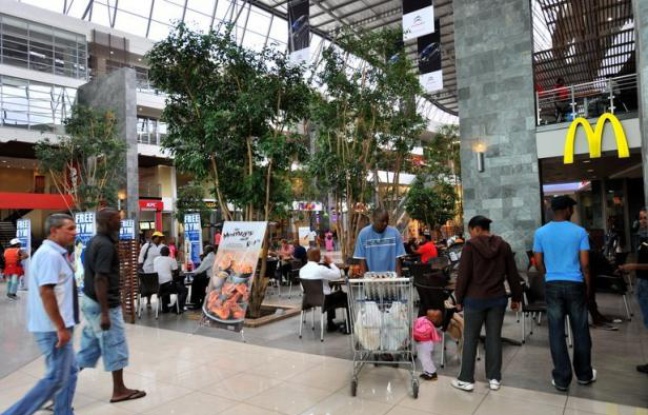Share this
Photo Courtesy
Why middle class Kenyans are living a lie
There is an eatery off Mombasa Road, Nairobi, that is just a spectacle of contrast. It is an old, rickety structure made of iron-sheet. Its walls and roof are black with soot. It is one of those eateries you would expect to find grease-laden unskilled workers from Industrial Area, silently wolfing a frugal meal of chapati and beans. Instead, there are sharply dressed customers. Men and women in crisp attire and suave mannerisms helping themselves to a sumptuous dish of chicken and ugali as they catch up on office politics. Besides the plate of ugali and chicken in front of one of the patrons is an expensive smartphone. And dangling on the index finger of his left hand is a car key, a symbol of his economic status. Taste for foreign things
Kenya Homes Expo targets middle-class home buyers
This is a member of the so-called Kenya’s ‘rising’ middle class, eating in a low-income eatery. Most of them will tell you that they are attracted to this place because of the taste; that they just love mama-kibanda more than the bigger establishments. But if you dig deeper, a many of them will confess that their pockets are not deep enough and they can’t afford a decent meal somewhere else. Indeed, there are a lot of ‘polished’ restaurants on NextGen Mall, along Mombasa Road. They serve exotic cuisines, from Ethiopian to Chinese, popular with the typical middle class with a taste for all things foreign. There is also Burger King and Domino’s Pizza outlets for fast food and Arsham for sit-down Chinese and Indian cuisine. And not very far from this mall is the American fast food restaurant KFC. But a decent meal in these restaurants will set them back by at least Sh500. If he eats here for 20 days, this would mean spending at least Sh10,000 on lunch alone. On the other hand, chicken and ugali at this roadside eating place goes for Sh160, totaling to Sh3,200 at the end of the month. This is relatively expensive for the middle class individual in formal wage employment who takes home, on average, a nominal salary of between Sh76,392 to Sh102,429, according to the latest report by the Institute of Economic Affairs (IEA). IEA’s report, “The Middle Class in Formal Sector in Kenya,” found that there are about 272,569 middle class wage employees in Kenya, with another 74,337 wage employees taking home more than the middle class. A whopping 2.13 million employees take home less than Sh49,000. Elite poor The World Bank puts the middle class individual’s or household’s daily income at between $10 and $50 (Sh1,031 and Sh5,158) per person per day. This works out to an average income of Sh27,000 to Sh140,000 a month. The African Development Bank (AfDB) defines middle class as anyone who spends between $2 and $20 a day (Sh200 and Sh2,000) — putting the middle class at 34 per cent of Africa’s population, or nearly 350 million people. “Even if you look at the definition of middle class as per the AfDB, I don’t think that someone who spends Sh2,000 a day and has a family and children really has much to spare,” says Anzetse Were, a development economist. She notes that most of these people’s income goes into supporting a lot of their poor relatives, leaving them with little disposable income. “I would define these as the elite poor and not really the middle class.” According to AfDB, middle class families “reside in big and more permanent dwellings equipped with modern amenities, widespread ownership of major household durable goods such as refrigerators, telephones and automobiles, salaried jobs, and smaller families.” Indeed, not most Kenyans have managed to fight off the allure of the middle class’ expensive life as the people eating at the roadside kiosk. Most of them have poured money into luxurious products found in the mushrooming malls, acquired new cars and bought homes in a bid to keep up with the Joneses. But in a volatile economic environment as Kenya’s where a job is not guaranteed, the effect has been devastating. “Middle class is more of a way of life and people have crafted that to live beyond their means,” says economist Dr Scholastica Odhiambo. She adds that a middle class person in Kenya tends to live in a relatively comfortable house with good sanitation, better roads and where transport is easy to find. However, most Kenyans have painstakingly tried to fit into the Hollywood-esque middle class description which is characterised by home ownership, car ownership, and having children in expensive private schools. This has eaten into their disposable income, leaving them in a precarious state. Consumer lending Kenya’s middle class households vigorously pushed on the dream of owning a car and a house, with threatening effects. Gullible Kenyans have in recent times been conned of millions of shillings after being duped that they would own homes cheaply. Set up in October 2015, a firm known as Simple Homes adopted a “pay rent, own home” model, raising the hopes of hundreds of thousands middle class Kenyans who could not afford to buy a home because of high mortgage rates. At least Sh500 million went down the drain as Simple Homes turned out to be yet another scam. The clamour for car-ownership has also brought misery upon most middle class families. “Since 2003, access to credit has been high. Today, even if you have a salary of Sh15,000 you can get a loan,” explains Odhiambo, adding that, unfortunately, people have taken loans as a short-term thing which they cannot sustain. According to a report by Financial Sector Deepening (FSD), with the expansion of bank branches, 73 per cent of the population now live within three kilometres of a financial sector touch point, increasing access to credit for most Kenyans. “In 2015, a network of approximately 68,000 agents had pushed out the access frontier, partly through a densification of access points,” said FSD. These loans have, however, been skewed towards salaried employees. “Lending patterns within the banking sector appear to be strongly linked to the rising middle class, with growth in lending largely focused on easy wins in consumer lending (especially payslip lending) and property markets,” added the FSD report. The middle class have in turn used the money to acquire consumer goods such as cars and household appliances as they try to ‘eat life,’ according to Odhiambo. As a result, motor vehicles imports have risen six-fold from 14,524 units in 2001 to 85,063 units in 2016, as the uptake of passenger cars among Kenyans swimming in easily gotten loans has dramatically gone up, according to official figures. Unfortunately, just as commercial loans have steadily risen to strike a high of Sh1.7 trillion in 2016, so has non-performing loans which hit 8.16 per cent in May last year. Unlike before, when ownership of a car was a preserve of a few rich people, today the new normal is car ownership for everyone. Perhaps, the people eating at the roadside kiosk are not middle class. Perhaps, a slum-dweller is more middle class than these people. Policymakers have struggled to define a middle class, with the definitions given not appreciating some realities such as the country’s ubiquitous informal sector. Informal sector “A landlord in Kibera slums who has 60 houses from which he gets Sh60,000 tax-free — and lives in Kibera, is classified as a poor person rather than a middle class, says Odhiambo. “So that demarcation is a thin line for policy-makers to know who is a middle class and who is not.” The term middle class emanated from a group of workers who neither the owners of capital nor the peasants who worked in the factories in the age of the industrial revolution. These ones sat in the offices, supervising the peasants on behalf of the nobles, and earned more than the industrial peasants. Back then, the term middle class was associated with formal employment. In Kenya, this is different. There are more self-employed Kenyans in the informal sector who are earning more than the wage employed workers. “You might also be living in a permanent house but your income is the minimum wage of Sh12,000,” she adds.
Source: https://www.standardmedia.co.ke





















